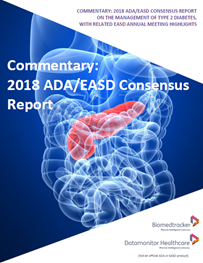Report Library
All Reports
DMHC/BMT Commentary: ADA/EASD 2018 Consensus Report on the Management of Type 2 Diabetes, with related EASD Annual Meeting Highlights
October 24, 2018
The final version of the 2018 American Diabetes Association (ADA)/European Association for the Study of Diabetes (EASD) Consensus
Report was released at the EASD Annual Meeting and published in the journals of each organization (Diabetes Care and Diabetologia). The report is an impressive document,
making recommendations for type 2 diabetes treatment based on a number of baseline co-morbidities or concerns: 1) established
atherosclerotic cardiovascular disease (ASCVD) or chronic kidney disease (CKD), where either ASCVD or heart failure (HF)/CKD
predominate, 2) a compelling need to minimize hypoglycemia, 3) a compelling need to minimize weight gain or promote weight loss, or
4) cost is a major issue.
While many of the considerations as to which drugs to use have already been known by physicians and guiding treatment for some time (eg hypoglycemia, weight effects, and cost), the focus on patients with ASCVD, HF, and CKD is still evolving, and the updated algorithm could boost use of the recommended drugs, though a presenter acknowledged at the EASD that implementing the guidelines so that physicians follow them is still a challenge. The new algorithm also does bring the various considerations into a new focus, though still emphasizing patient preference and other characteristics of the treatment choices. In addition, usage will be impacted by further data from related studies that will be released in the near term and next few years, including more information on the amputation risk with SGLT-2 inhibitors.
This commentary highlights and discusses major points from the consensus report, as well as related data released at the EASD Annual Meeting, held 1—5 October 2018 in Berlin, Germany.
Like our report? Have any questions or feedback? Please let us know at askanalyst@sagientresearch.com.
For our disclosures, please read the Biomedtracker Research Standards.
While many of the considerations as to which drugs to use have already been known by physicians and guiding treatment for some time (eg hypoglycemia, weight effects, and cost), the focus on patients with ASCVD, HF, and CKD is still evolving, and the updated algorithm could boost use of the recommended drugs, though a presenter acknowledged at the EASD that implementing the guidelines so that physicians follow them is still a challenge. The new algorithm also does bring the various considerations into a new focus, though still emphasizing patient preference and other characteristics of the treatment choices. In addition, usage will be impacted by further data from related studies that will be released in the near term and next few years, including more information on the amputation risk with SGLT-2 inhibitors.
This commentary highlights and discusses major points from the consensus report, as well as related data released at the EASD Annual Meeting, held 1—5 October 2018 in Berlin, Germany.
Like our report? Have any questions or feedback? Please let us know at askanalyst@sagientresearch.com.
For our disclosures, please read the Biomedtracker Research Standards.
| Indications Covered: |
Acute Coronary Syndrome (ACS)
Chronic Heart Failure - Reduced Ejection Fraction (Chronic HFrEF) Coronary Artery Disease Diabetes Mellitus, Type II Diabetic Nephropathy Obesity |
Additional Resources:
- 2018 Biomedtracker / Datamonitor Healthcare / Meddevicetracker Post-ESC Report
- 2018 Biomedtracker / Datamonitor Healthcare / Meddevicetracker Post-ADA Report
- 2018 Biomedtracker / Meddevicetracker / Datamonitor Healthcare Post-ACC Report
- Diabetic Nephropathy Pulse Survey
- Datamonitor Healthcare Type 2 Diabetes KOL Interview – Italy
- Datamonitor Healthcare Type 2 Diabetes KOL Interview – UK
- Datamonitor Healthcare Type 2 Diabetes KOL Interview – US
